Pinar Yanardag
Plot'n Polish: Zero-shot Story Visualization and Disentangled Editing with Text-to-Image Diffusion Models
Sep 04, 2025Abstract:Text-to-image diffusion models have demonstrated significant capabilities to generate diverse and detailed visuals in various domains, and story visualization is emerging as a particularly promising application. However, as their use in real-world creative domains increases, the need for providing enhanced control, refinement, and the ability to modify images post-generation in a consistent manner becomes an important challenge. Existing methods often lack the flexibility to apply fine or coarse edits while maintaining visual and narrative consistency across multiple frames, preventing creators from seamlessly crafting and refining their visual stories. To address these challenges, we introduce Plot'n Polish, a zero-shot framework that enables consistent story generation and provides fine-grained control over story visualizations at various levels of detail.
Audit & Repair: An Agentic Framework for Consistent Story Visualization in Text-to-Image Diffusion Models
Jun 23, 2025Abstract:Story visualization has become a popular task where visual scenes are generated to depict a narrative across multiple panels. A central challenge in this setting is maintaining visual consistency, particularly in how characters and objects persist and evolve throughout the story. Despite recent advances in diffusion models, current approaches often fail to preserve key character attributes, leading to incoherent narratives. In this work, we propose a collaborative multi-agent framework that autonomously identifies, corrects, and refines inconsistencies across multi-panel story visualizations. The agents operate in an iterative loop, enabling fine-grained, panel-level updates without re-generating entire sequences. Our framework is model-agnostic and flexibly integrates with a variety of diffusion models, including rectified flow transformers such as Flux and latent diffusion models such as Stable Diffusion. Quantitative and qualitative experiments show that our method outperforms prior approaches in terms of multi-panel consistency.
Dynamic View Synthesis as an Inverse Problem
Jun 09, 2025Abstract:In this work, we address dynamic view synthesis from monocular videos as an inverse problem in a training-free setting. By redesigning the noise initialization phase of a pre-trained video diffusion model, we enable high-fidelity dynamic view synthesis without any weight updates or auxiliary modules. We begin by identifying a fundamental obstacle to deterministic inversion arising from zero-terminal signal-to-noise ratio (SNR) schedules and resolve it by introducing a novel noise representation, termed K-order Recursive Noise Representation. We derive a closed form expression for this representation, enabling precise and efficient alignment between the VAE-encoded and the DDIM inverted latents. To synthesize newly visible regions resulting from camera motion, we introduce Stochastic Latent Modulation, which performs visibility aware sampling over the latent space to complete occluded regions. Comprehensive experiments demonstrate that dynamic view synthesis can be effectively performed through structured latent manipulation in the noise initialization phase.
LoRAShop: Training-Free Multi-Concept Image Generation and Editing with Rectified Flow Transformers
May 29, 2025Abstract:We introduce LoRAShop, the first framework for multi-concept image editing with LoRA models. LoRAShop builds on a key observation about the feature interaction patterns inside Flux-style diffusion transformers: concept-specific transformer features activate spatially coherent regions early in the denoising process. We harness this observation to derive a disentangled latent mask for each concept in a prior forward pass and blend the corresponding LoRA weights only within regions bounding the concepts to be personalized. The resulting edits seamlessly integrate multiple subjects or styles into the original scene while preserving global context, lighting, and fine details. Our experiments demonstrate that LoRAShop delivers better identity preservation compared to baselines. By eliminating retraining and external constraints, LoRAShop turns personalized diffusion models into a practical `photoshop-with-LoRAs' tool and opens new avenues for compositional visual storytelling and rapid creative iteration.
CREA: A Collaborative Multi-Agent Framework for Creative Content Generation with Diffusion Models
Apr 07, 2025Abstract:Creativity in AI imagery remains a fundamental challenge, requiring not only the generation of visually compelling content but also the capacity to add novel, expressive, and artistically rich transformations to images. Unlike conventional editing tasks that rely on direct prompt-based modifications, creative image editing demands an autonomous, iterative approach that balances originality, coherence, and artistic intent. To address this, we introduce CREA, a novel multi-agent collaborative framework that mimics the human creative process. Our framework leverages a team of specialized AI agents who dynamically collaborate to conceptualize, generate, critique, and enhance images. Through extensive qualitative and quantitative evaluations, we demonstrate that CREA significantly outperforms state-of-the-art methods in diversity, semantic alignment, and creative transformation. By structuring creativity as a dynamic, agentic process, CREA redefines the intersection of AI and art, paving the way for autonomous AI-driven artistic exploration, generative design, and human-AI co-creation. To the best of our knowledge, this is the first work to introduce the task of creative editing.
ConceptAttention: Diffusion Transformers Learn Highly Interpretable Features
Feb 06, 2025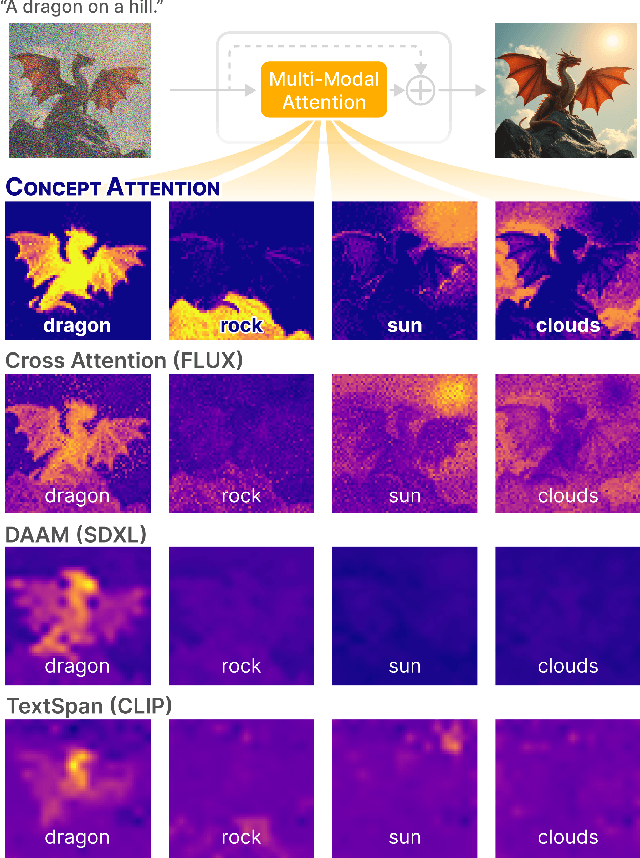
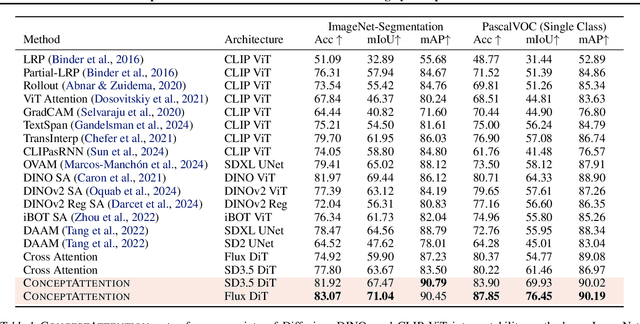

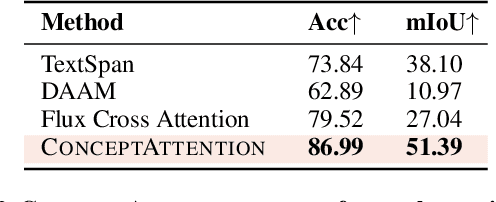
Abstract:Do the rich representations of multi-modal diffusion transformers (DiTs) exhibit unique properties that enhance their interpretability? We introduce ConceptAttention, a novel method that leverages the expressive power of DiT attention layers to generate high-quality saliency maps that precisely locate textual concepts within images. Without requiring additional training, ConceptAttention repurposes the parameters of DiT attention layers to produce highly contextualized concept embeddings, contributing the major discovery that performing linear projections in the output space of DiT attention layers yields significantly sharper saliency maps compared to commonly used cross-attention mechanisms. Remarkably, ConceptAttention even achieves state-of-the-art performance on zero-shot image segmentation benchmarks, outperforming 11 other zero-shot interpretability methods on the ImageNet-Segmentation dataset and on a single-class subset of PascalVOC. Our work contributes the first evidence that the representations of multi-modal DiT models like Flux are highly transferable to vision tasks like segmentation, even outperforming multi-modal foundation models like CLIP.
Explaining in Diffusion: Explaining a Classifier Through Hierarchical Semantics with Text-to-Image Diffusion Models
Dec 24, 2024



Abstract:Classifiers are important components in many computer vision tasks, serving as the foundational backbone of a wide variety of models employed across diverse applications. However, understanding the decision-making process of classifiers remains a significant challenge. We propose DiffEx, a novel method that leverages the capabilities of text-to-image diffusion models to explain classifier decisions. Unlike traditional GAN-based explainability models, which are limited to simple, single-concept analyses and typically require training a new model for each classifier, our approach can explain classifiers that focus on single concepts (such as faces or animals) as well as those that handle complex scenes involving multiple concepts. DiffEx employs vision-language models to create a hierarchical list of semantics, allowing users to identify not only the overarching semantic influences on classifiers (e.g., the 'beard' semantic in a facial classifier) but also their sub-types, such as 'goatee' or 'Balbo' beard. Our experiments demonstrate that DiffEx is able to cover a significantly broader spectrum of semantics compared to its GAN counterparts, providing a hierarchical tool that delivers a more detailed and fine-grained understanding of classifier decisions.
PRIMA: Multi-Image Vision-Language Models for Reasoning Segmentation
Dec 19, 2024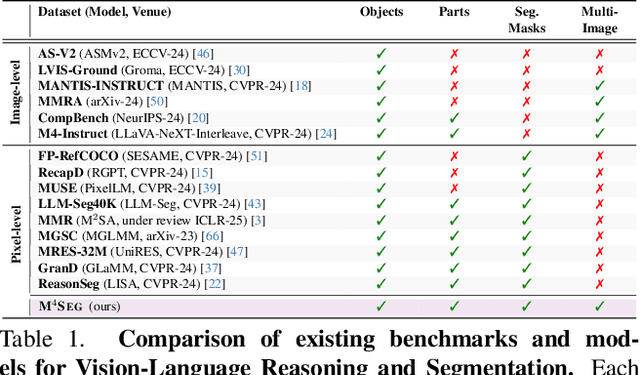
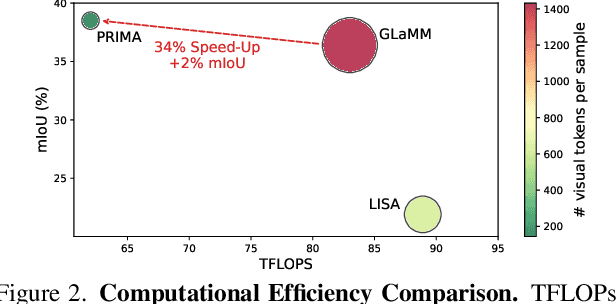
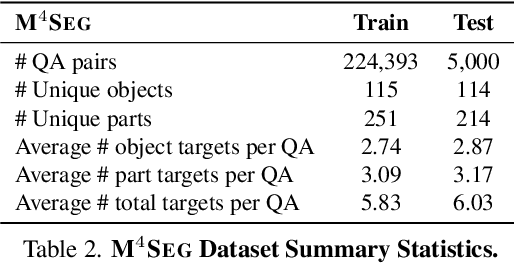
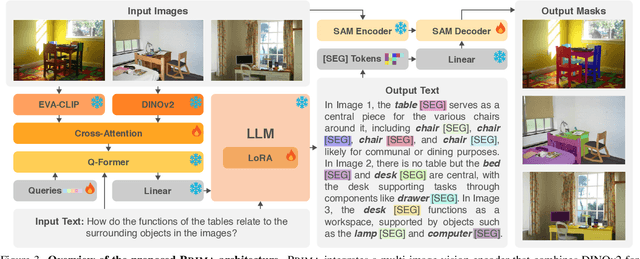
Abstract:Despite significant advancements in Large Vision-Language Models (LVLMs), existing pixel-grounding models operate on single-image settings, limiting their ability to perform detailed, fine-grained comparisons across multiple images. Conversely, current multi-image understanding models lack pixel-level grounding. Our work addresses this gap by introducing the task of multi-image pixel-grounded reasoning segmentation, and PRIMA, a novel LVLM that integrates pixel-level grounding with robust multi-image reasoning capabilities to produce contextually rich, pixel-grounded explanations. Central to PRIMA is an efficient vision module that queries fine-grained visual representations across multiple images, reducing TFLOPs by $25.3\%$. To support training and evaluation, we curate $M^4Seg$, a new reasoning segmentation benchmark consisting of $\sim$224K question-answer pairs that require fine-grained visual understanding across multiple images. Experimental results demonstrate PRIMA outperforms state-of-the-art baselines.
Context Canvas: Enhancing Text-to-Image Diffusion Models with Knowledge Graph-Based RAG
Dec 12, 2024Abstract:We introduce a novel approach to enhance the capabilities of text-to-image models by incorporating a graph-based RAG. Our system dynamically retrieves detailed character information and relational data from the knowledge graph, enabling the generation of visually accurate and contextually rich images. This capability significantly improves upon the limitations of existing T2I models, which often struggle with the accurate depiction of complex or culturally specific subjects due to dataset constraints. Furthermore, we propose a novel self-correcting mechanism for text-to-image models to ensure consistency and fidelity in visual outputs, leveraging the rich context from the graph to guide corrections. Our qualitative and quantitative experiments demonstrate that Context Canvas significantly enhances the capabilities of popular models such as Flux, Stable Diffusion, and DALL-E, and improves the functionality of ControlNet for fine-grained image editing tasks. To our knowledge, Context Canvas represents the first application of graph-based RAG in enhancing T2I models, representing a significant advancement for producing high-fidelity, context-aware multi-faceted images.
FluxSpace: Disentangled Semantic Editing in Rectified Flow Transformers
Dec 12, 2024



Abstract:Rectified flow models have emerged as a dominant approach in image generation, showcasing impressive capabilities in high-quality image synthesis. However, despite their effectiveness in visual generation, rectified flow models often struggle with disentangled editing of images. This limitation prevents the ability to perform precise, attribute-specific modifications without affecting unrelated aspects of the image. In this paper, we introduce FluxSpace, a domain-agnostic image editing method leveraging a representation space with the ability to control the semantics of images generated by rectified flow transformers, such as Flux. By leveraging the representations learned by the transformer blocks within the rectified flow models, we propose a set of semantically interpretable representations that enable a wide range of image editing tasks, from fine-grained image editing to artistic creation. This work offers a scalable and effective image editing approach, along with its disentanglement capabilities.
 Add to Chrome
Add to Chrome Add to Firefox
Add to Firefox Add to Edge
Add to Edge